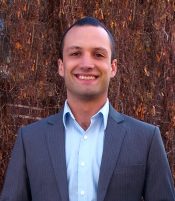ATSU-SOMA student changes Wyoming’s eating standard
Posted: October 14, 2016
Jesse Miller, OMS IV, first came to A.T. Still University on a Western Interstate Commission for Higher Education (WICHE) Professional Student Exchange Program scholarship for his medical school education. During his third year at ATSU’s School of Osteopathic Medicine in Arizona (ATSU-SOMA), Miller began working on a project to encourage healthy eating by providing locally grown food to residents in his native state, Wyoming, beginning in 2015.
Miller recognized that creating healthier environments and improving access to healthy foods improves individual and community health is widely accepted. But while this connection between health and environment is widely recognized, he found there are few examples of partnerships between health, food policy, and economic development to influence health outcomes through coordinated design, implementation, and monitoring of changes to the food system.
“In order to create healthier environments and improve access to healthier foods, there is a need to acquire thorough market information about local food supply and demand, local trends, and barriers to expanding the local food system,” says Miller. “So, my hypothesis was that increasing fruit and vegetable consumption would improve long-term health outcomes in Wyoming.”
As such, Miller began his project by detailing the linkage between chronic diseases, vegetable consumption, and poor access to healthy foods, then outlined a proposal and implemented food system and nutrition development plans for Wyoming. As a result, Miller’s proposed food system and nutritional plans were implemented at economic and educational sectors at community and statewide levels.
Economically, he developed an ecommerce farmers’ market and successful Summer Community Supported Agriculture (CSA) program. CSA emphasizes the health and economic benefits of local food and sourced products from Wyoming farms. Over 15 pounds of fresh, local vegetables were delivered to community centers and workplaces weekly throughout the summer. As a result, CSA successfully increased the availability of fresh, local produce.
“Local produce is normally available to people through the farmers’ market distribution channels and the CSA program extended availability by four weeks and a 45 percent increase. It is now in its second year of operation,” says Miller.
On a larger economic scale, Miller wrote and received two $25,000 U.S. Department of Agriculture Local Food Promotion Program grants to explore innovative models to unite community health and local food system development throughout Wyoming. The first grant, written and received in 2015 during his third year at ATSU-SOMA, focused on a community food assessment for a food hub feasibility in Casper, Wyoming. A food hub is a business or organization that actively manages the aggregation, distribution, and marketing of source-identified food products primarily from local and regional producers to strengthen their ability to satisfy wholesale, retail, and institutional demand.
“Essentially, the project outlined the community resources and feasibility of developing a local food system in the Casper area with recommendations on how to move forward with development,” says Miller.
After receiving the grant, Miller conducted the project remotely from Mesa, Arizona while studying on-campus.
The second grant, awarded in 2016, was to conduct a statewide Wyoming food hub network assessment and feasibility study. After receiving his second grant, Miller took an advanced study year to pursue this study directly in Wyoming. This study was a continuation of the previous grant that followed the recommendation to assess the feasibility of connecting the local food system in the large geographic region and low population areas of Wyoming.
“The goal of the project was to enhance local food system and health development in Wyoming,” says Miller. “In fact, the results were published and have led to the development of the Wyoming Farm-to-Plate Task Force, a Wyoming-based group developing a robust local food system in Wyoming.”
The Wyoming Farm-to-Plate Task Force was formed to provide a consistent and unified foundation for Wyoming Farm to Plate stakeholders with an interest in developing the local food system in Wyoming. As Task Force Chair, Miller organizes and moderates statewide meetings to bring local food participants together in conversation and developed monthly communication tools to keep stakeholders updated.
At the community level, a stakeholder group was formed as a recommendation of the local non-profit hospital’s Community Health Needs Assessment. A student-parent health fair was also held, and focused on at-risk youth for low-income schools in Natrona County. The goal of the health fair was to teach both students and parents healthy eating habits and the benefits of physical activity.
Miller also organized and incorporated local non-profit to link local food and community health. As President/CEO Miller raised over $240,000 to develop school and community garden programs in the community.
“To date, we have built two learning greenhouses at low-income elementary schools and developed after-school Garden Club programs,” he says.
Now in his fourth year at ATSU-SOMA, Miller is currently writing a Community Oriented Primary Care paper outlining this project titled, “Healthy Eating Through Local Food.” This paper will highlight the synergies between community health and economic development and their potential to promote healthy eating.
Following graduation, Miller plans to fulfill his obligation from his scholarship to practice in Wyoming for three years, while continuing to serve the underserved in his home state.